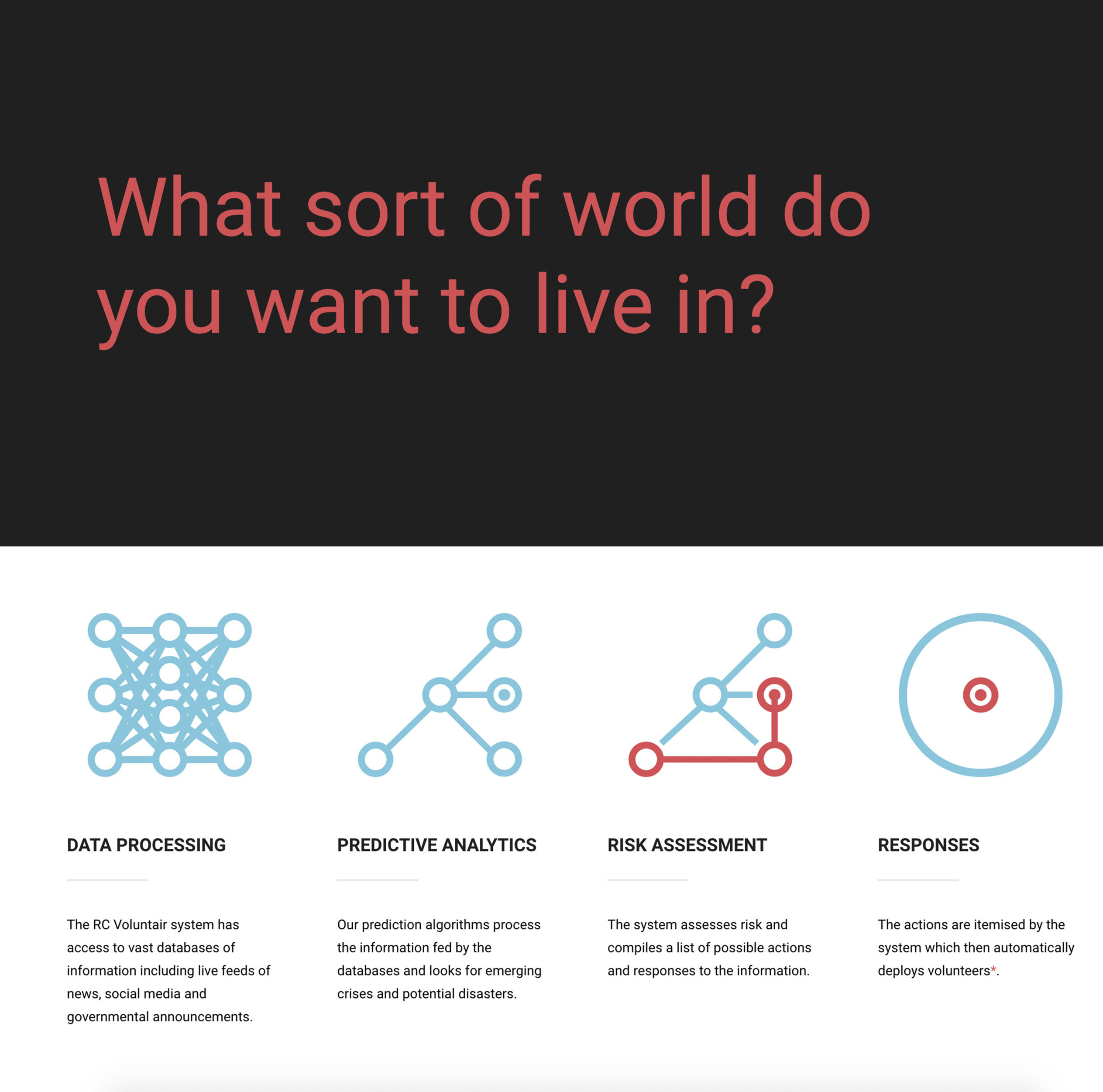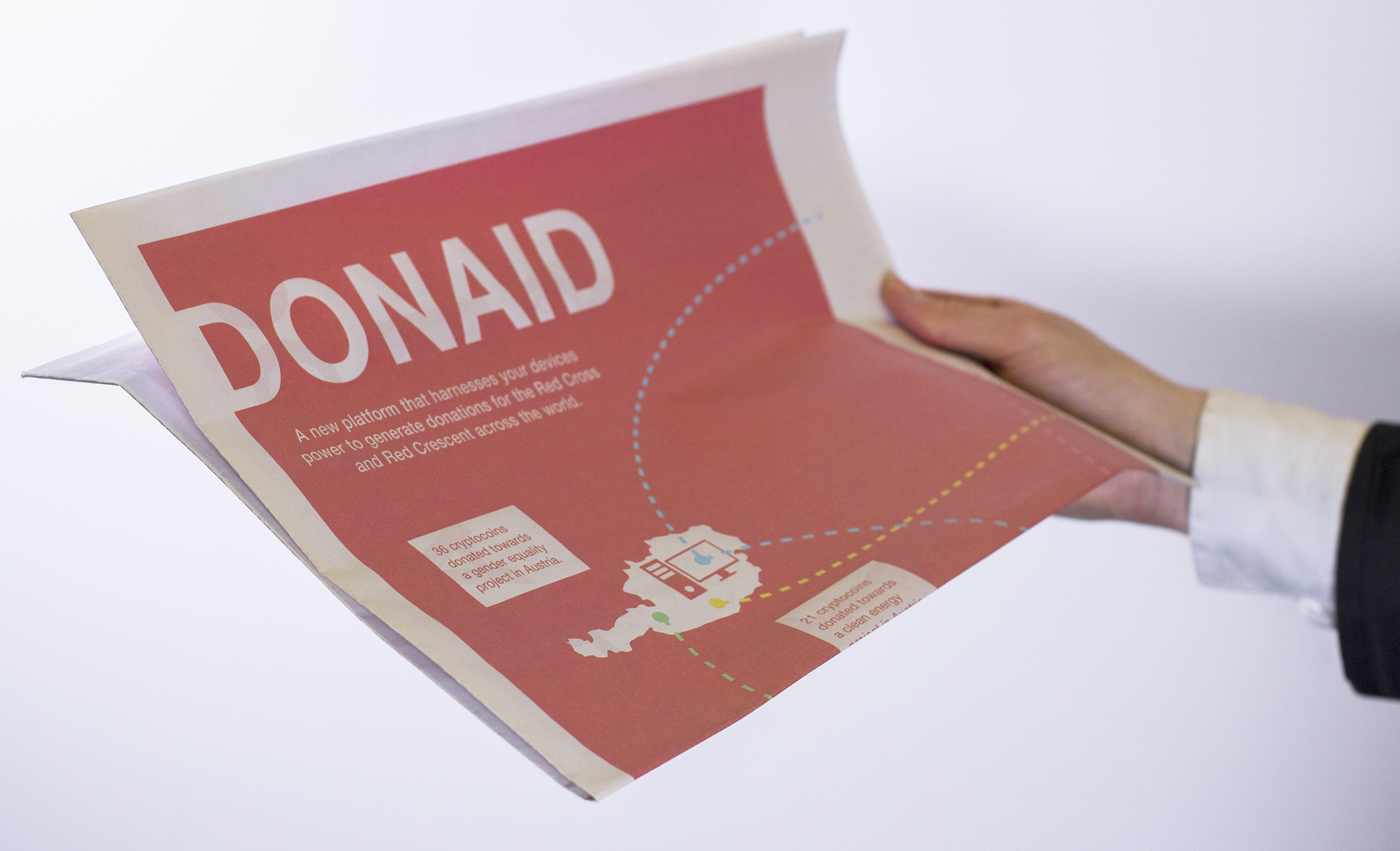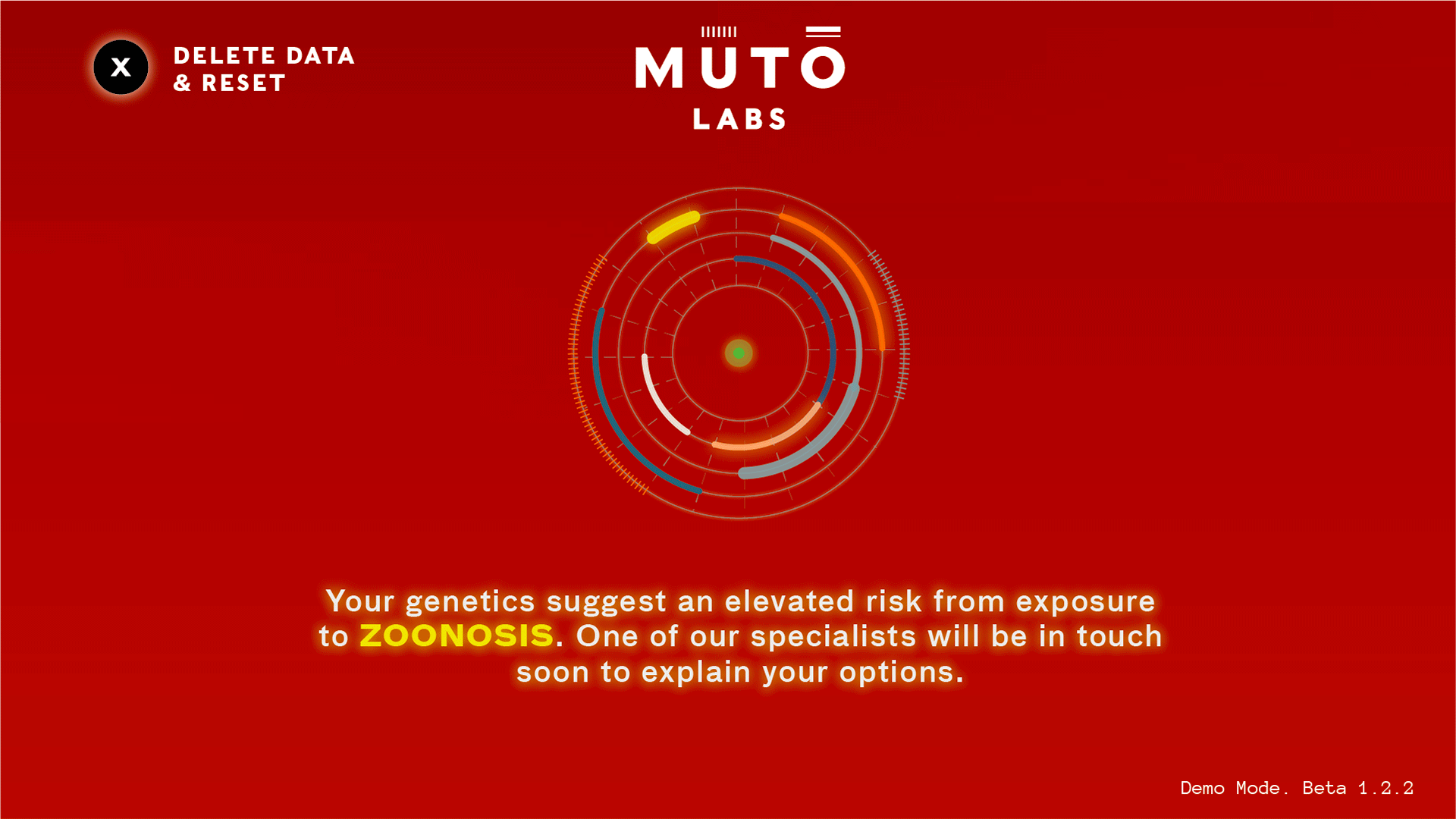Projects
EVIDENCING HUMANITARIAN FUTURES
At the end of 2017, the International Federation of Red Cross (IFRC) launched ‘The Future is Now’ exhibition at their conference. We were invited to speculate and provoke attendees into anticipating the technological, social and economic challenges that the humanitarian and development sector might face in the near future. Other organisations invited to contribute included our friends at Changeist and Situation Lab.
Today, there are a proliferation of increasingly sophisticated, intelligent predictive systems which help forecast the future and probabilistically model next steps. But uncertainty will only become amplified when civic unrest and new conflict zones compound with growing inequality, climate change and technological acceleration. Humanitarian organisations need more than the current predictive toolkit, which tends to point to a single probable future.
We worked closely with the team at the IFRC to better understand some of the complex challenges facing their organisation. Whilst the IFRC takes pride in its excellent volunteering and crisis response, the real challenge for the organisation is finding a way to cultivate a proactive and anticipatory culture, and to scale operations and efficiently manage resources in the context of accelerated infrastructural, technological and economic shifts.
With a series of speculative design provocations and technological interventions we presented the early warning signs. We have learned that people must experience these signals first hand to comprehend them. Only by directly confronting the materiality and evidential reality of some of the very plausible alternative nows and near futures, are they able to change the way people make decisions. We wanted to empower the IFRC leadership to prepare for and anticipate change: to feel confident in making plans and testing them, whilst contributing to a cross-departmental culture of anticipation and preparedness. Crucially, we wanted to show that one of the greatest advantages an organisation in today’s world has for thriving and surviving is to directly engage with multiple future possibilities.
Provocations, concepts and artefacts
Based on IFRC’s thematic challenges, we identified four key spheres of concern and opportunity, and generated experiential evidences for each of them.
1. How might AI shift the players in the field, and what might the implications be?
To explore this question, we created “RC VoluntAIr”: a predictive artificial intelligence organisation that smartly deploys volunteers in disaster areas.
This algorithm-run organisation becomes a central node in the spirit of collaboration; connecting skills volunteered from citizens across the world based upon project resource wish-lists.
RC VoluntAIr uses applied and predictive analytics for humanitarian aid distribution. An artificial intelligence oversees a global network of real-time news feeds, data sets and volunteers to identify potential disasters before allocating aid and humanitarian relief where, and when it is most needed. Volunteer recruitment, categorisation and mobilisation are all uniquely mapped and managed by the AI. By applying a crowdsourcing model to volunteering, people can easily register their interest with minimal commitment. Volunteers are indexed by their skillsets and geolocation when they sign up, then contacted to make a targeted contribution as and when they are needed. Predictive distribution strategies also mean aid infrastructures are in place before natural disasters and crises happen.

This provocation was intended to help IFRC re-imagine their volunteering and infrastructural capacities and the power of their networks. We also wanted to introduce the real technological possibilities around AI that the organisation will be soon be forced to consider. How will a distributed, real-time, non-hierarchical, non-bureaucratic volunteering model impact a traditional humanitarian organisation?
And, more importantly, what decisions will humanitarian organisations burdened with funding cuts make around such technologies, which raise deep concerns over accountability, ethics, regulation and trust?
2. How might alternate finance strategies change sponsorship and donor based funding models?

To explore this question, we created ‘DONAID’: a future donation platform where a person can convert their computer/device processing power into a virtual cryptocurrency and donate this currency to the Red Cross and Red Crescent for a cause of their choice.
Cryptocurrency mining is widely recognised as having a damaging environment impact, consuming vast amounts of power to generate currency. To rectify this, the DONAID model functions by small but frequent currency generation sessions; a user would dedicate between 1% and 20% or 1 – 20 mins of power to mining a small amount of cryptocurrency per day. The “coins” or money created is donated to the RCRC. This, seemingly more ethical form of cryptocurrency prioritises transaction verification over mining, meaning that extensive specialised hardware doesn’t have any advantage over your regular computer or device.
A personalised DONAID dashboard helps people track the journey their donation takes from the point of contribution to the degree of social impact it makes. The concept for this artefact is derived from current financial trends, distributed ledger technologies and the growing demand for more inclusive, transparent, and holistic value systems.
3. How might predictive genetics and healthcare change humanitarian responses?

To explore this question, we demonstrated a ‘Genetic disease scanner’, which we imagine would be used by various government and humanitarian organisations to track diseases likely to spread in the future.
The Genetic Scanner takes quick saliva swabs before processing them to identify people who might have genetic predispositions to certain diseases, or the capacity for disease resistance. This sort of genetic testing helps guide action and treatment to mitigate epidemics.
This concept was derived from recent developments in healthcare technology, including personalised home DNA testing, data-driven medicine, and citizen science platforms. Government border agencies have also used DNA testing in recent years to identify the nationalities of refugees. Collaborations between humanitarian organisations and health and medical agencies are not uncommon. These existing indicators helped us imagine a near-future where governments and humanitarian organisations could plausibly use a device like the Genetic Disease Scanner.
While a preventative approach has obvious humanitarian benefits, there are implications involving privately owned genomics companies monitoring genetic data that IFRC would need to consider. The establishment of regulations within the health and insurance sector and around personal health data security, anonymity and objectivity (rather than commerce-driven) assessment would need to be made.
4. How might experiential evidences of climate change influence decisions made today?
To explore this question, we presented the ‘Air pollution inhaler’ created for the Future Energy Lab. The air pollution inhalator allows people to breathe a sample of air as it would be around 2030 if our harmful polluting behaviours in the present continue. The sample was produced in collaboration with chemical scientists from the University of Ahmedabad and contains PM10, PM2.5, carbon monoxide, sulphur dioxide, nitrogen dioxide and ozone. Anyone who comes in contact with the noxious mix immediately realises this is not a future environment they want their children to inherit.
Impact and Value
Our work with IFRC focused on extrapolating multiple trends and weak signals to generate a breath of possible futures. This unique combination of strategic foresight and speculative design is a powerful mechanism to surface the potential, as well as the unintended consequences, of the systems that will be designed and built. Direct engagement with these possibilities is critical to make more thoughtful, informed decisions today – about what we build, where we allocate resources, and what we want to affect.
We were happy with the outcomes and are thankful for the opportunity to show this work at The Future Is Now, event at IFRC headquarters, and numerous follow up events across IFRC offices. Read more about it here.
Shaun Hazeldine, Head of Innovation and Futures at IFRC had this to say about our work with them:
“We engaged Superflux to work with us on conceptualising, designing and implementing a major experiential futures exhibition for the International Federation of Red Cross and Red Crescent in late 2017. The experiential futures piece for the International Federation of Red Cross and Red Crescent in late 2017 targeted over 1,000 executive leaders within the IFRC network and aimed to help them think about potential humanitarian futures and to be passionate about the possibilities for change within a new and upcoming global strategy process. Superflux were fantastic to work with, they took time to understand our needs, the content we wanted to convey and more importantly, the dynamics, culture and nuances of our organisation and this project. They turned work around very quickly and we were highly impressed with the creativity, accuracy and overall impact of their work. They were professional attentive and committed to quality and creating standout products. We were able to achieve our objectives and more, in no small part as a result of the contribution of Superflux.”